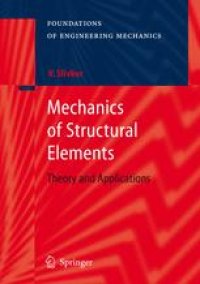
Ebook: Mechanics of Structural Elements: Theory and Applications
Author: Vladimir Slivker (auth.)
- Tags: Structural Mechanics, Appl.Mathematics/Computational Methods of Engineering, Computational Intelligence
- Series: Foundations Engineering Mechanics
- Year: 2007
- Publisher: Springer-Verlag Berlin Heidelberg
- Edition: 1
- Language: English
- pdf
The book systematically presents variational principles and methods of analysis for applied elasticity and structural mechanics. The variational approach is used consistently for both, constructing numerical procedures and deriving basic governing equations of applied mechanics of solids; it is the derivation of equations where this approach is most powerful and best grounded by mathematics. The book is oriented towards experts in civil engineering, researchers, developers of software for mechanical strength, stability, and oscillation analysis; it can be used by practical engineers who employ software tools to do their job and who want to know more about the theoretical background of the strength analysis. The book will be useful to senior and postgraduate students of engineering, to professors of structural analysis at civil or mechanical engineering departments of technical universities.
The book systematically presents variational principles and methods of analysis for applied elasticity and structural mechanics. The variational approach is used consistently for both, constructing numerical procedures and deriving basic governing equations of applied mechanics of solids; it is the derivation of equations where this approach is most powerful and best grounded by mathematics. The book is oriented towards experts in civil engineering, researchers, developers of software for mechanical strength, stability, and oscillation analysis; it can be used by practical engineers who employ software tools to do their job and who want to know more about the theoretical background of the strength analysis. The book will be useful to senior and postgraduate students of engineering, to professors of structural analysis at civil or mechanical engineering departments of technical universities.
The book systematically presents variational principles and methods of analysis for applied elasticity and structural mechanics. The variational approach is used consistently for both, constructing numerical procedures and deriving basic governing equations of applied mechanics of solids; it is the derivation of equations where this approach is most powerful and best grounded by mathematics. The book is oriented towards experts in civil engineering, researchers, developers of software for mechanical strength, stability, and oscillation analysis; it can be used by practical engineers who employ software tools to do their job and who want to know more about the theoretical background of the strength analysis. The book will be useful to senior and postgraduate students of engineering, to professors of structural analysis at civil or mechanical engineering departments of technical universities.
Content:
Front Matter....Pages I-XXVII
Basic Variational Principles of Static and Geometry in Structural Mechanics....Pages 1-28
Basic Variational Principles of Structural Mechanics....Pages 29-97
Additional Variational Principles of Structural Mechanics....Pages 99-133
Particular Classes of Problems in Structural Mechanics – Part 1....Pages 135-220
Particular Classes of Problems in Structural Mechanics – Part 2....Pages 221-311
Particular Classes of Problems in Structural Mechanics – Part 3....Pages 313-393
Particular Classes of Problems in Structural Mechanics – Part 4....Pages 395-457
Particular Classes of Problems in Structural Mechanics – Part 5....Pages 459-495
The Ritz Method and its Modifications....Pages 497-538
Variational Principles in Spectral Problems....Pages 539-604
Variational Principles in Stability/Buckling Analysis....Pages 605-699
Back Matter....Pages 701-787
The book systematically presents variational principles and methods of analysis for applied elasticity and structural mechanics. The variational approach is used consistently for both, constructing numerical procedures and deriving basic governing equations of applied mechanics of solids; it is the derivation of equations where this approach is most powerful and best grounded by mathematics. The book is oriented towards experts in civil engineering, researchers, developers of software for mechanical strength, stability, and oscillation analysis; it can be used by practical engineers who employ software tools to do their job and who want to know more about the theoretical background of the strength analysis. The book will be useful to senior and postgraduate students of engineering, to professors of structural analysis at civil or mechanical engineering departments of technical universities.
Content:
Front Matter....Pages I-XXVII
Basic Variational Principles of Static and Geometry in Structural Mechanics....Pages 1-28
Basic Variational Principles of Structural Mechanics....Pages 29-97
Additional Variational Principles of Structural Mechanics....Pages 99-133
Particular Classes of Problems in Structural Mechanics – Part 1....Pages 135-220
Particular Classes of Problems in Structural Mechanics – Part 2....Pages 221-311
Particular Classes of Problems in Structural Mechanics – Part 3....Pages 313-393
Particular Classes of Problems in Structural Mechanics – Part 4....Pages 395-457
Particular Classes of Problems in Structural Mechanics – Part 5....Pages 459-495
The Ritz Method and its Modifications....Pages 497-538
Variational Principles in Spectral Problems....Pages 539-604
Variational Principles in Stability/Buckling Analysis....Pages 605-699
Back Matter....Pages 701-787
....